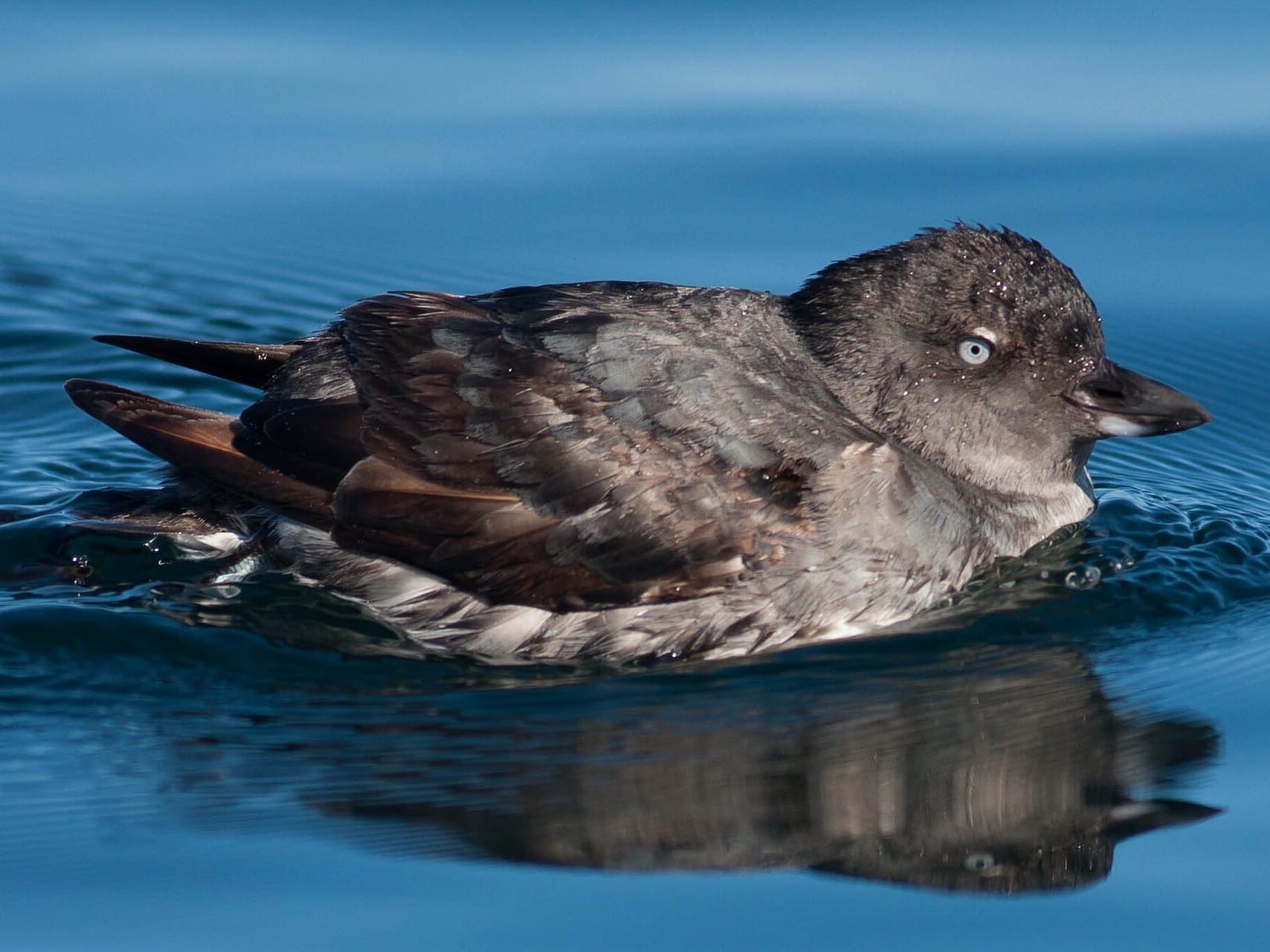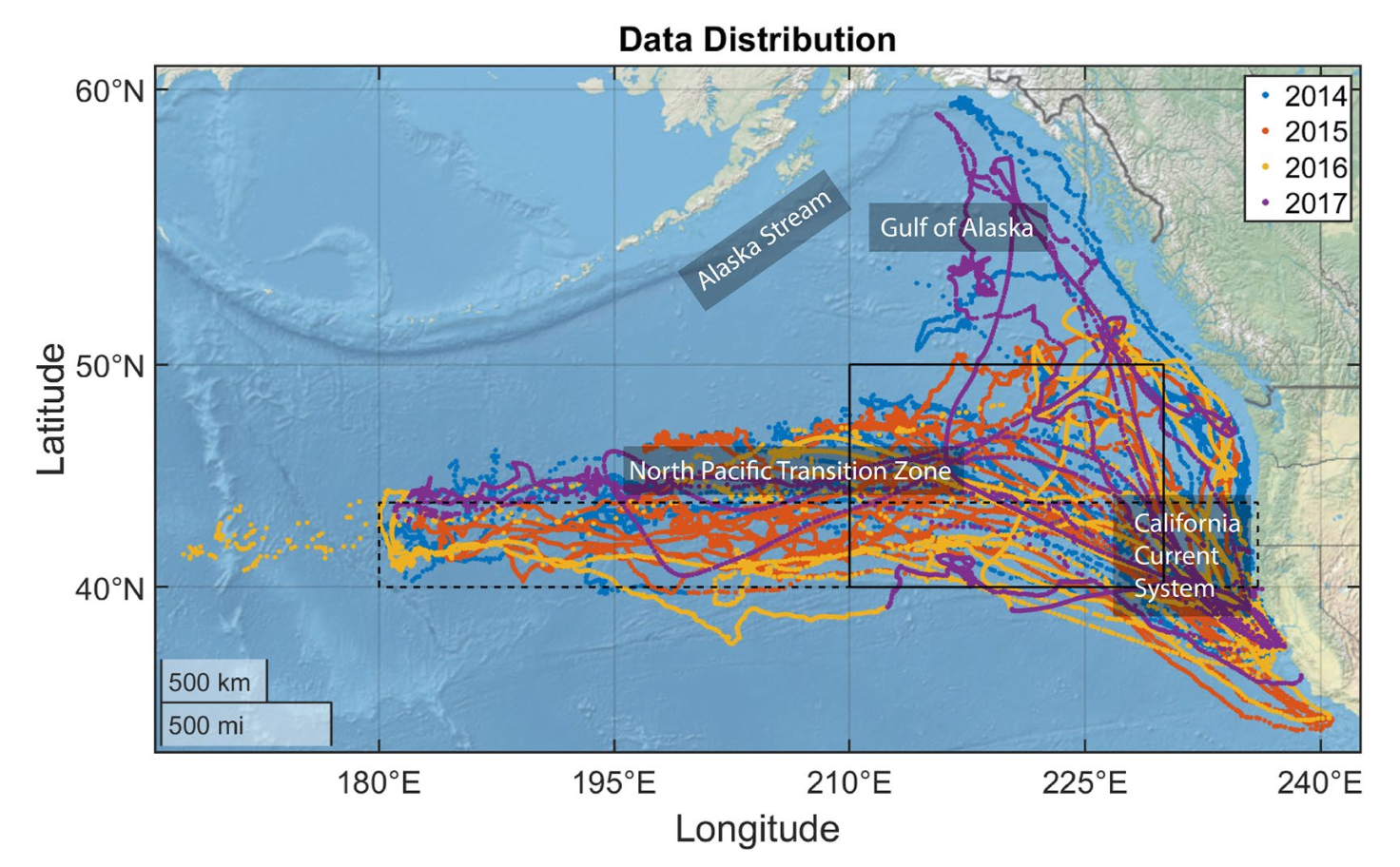the blob
welcome to A Teetering Vulture! a newsletter about various science stuff as well as the life happenings of its author, Taylor.

I have been told, by friends of a volunteer at the Monterey Bay Aquarium in Central California, that common murres possess an amicable disposition. They are gentle, trusting birds, and they are shaped like large black and white footballs, with feet near the end of their torsos, almost like a penguin’s would be, and a remarkable penchant for diving. (In the wild, they can dive up to 590 feet to catch prey). The Monterey Bay Aquarium houses a small common murre colony, in addition to a panoply of rehabilitated seabirds. I have visited the aquarium multiple times on trips to visit my twin, who lives in the nearby inland town of Salinas, and each time have been captivated by the perfectly stilted legs on which a diversity of shorebirds stand, delicately amble, or hurriedly skedaddle around their chest-high, sandy aviary. From the elegant and relatively large and wonderfully named Marbled Godwit to the miniature Red-Necked Phalarope, each is so clearly, when you see them up close, a being evolved for the complex, difficult, and wondrous task of survival on the sea. Though the rehabilitated birds housed in the aquarium may no longer be suited to that wild existence, beyond them, beyond a towering glass wall, stretches the endless Pacific that their species writ large call home.
There are at least ninety seabird species that call Monterey Bay home at some point in the year, and each one finds itself, in the present day, contending with the effects of an anthropogenically altered climate not only in the air and on land—California has seen mercurial fluctuations in its atmospheric climate in the past several decades, unprecedented droughts, wildfires, and rains some of the results, which have altered the terrestrial environments these birds call home—but also in the water.
In addition to sea level rise, coastal flooding and coastal erosion, all indicators of climate change that California has been monitoring for more than a century, marine heatwaves pose a new and intimidating threat to the state’s ecosystems. Beginning in late 2013 and persisting into early 2017, a mysterious and extreme marine heatwave ominously dubbed “The Blob” infiltrated an enormous swath of the northern Pacific Ocean, stretching from central North America up into the Gulf of Alaska. Marine heatwaves occur when sea surface temperatures rise anomalously. In comparison to atmospheric heatwaves, marine heatwaves have only caught scientists’ attention relatively recently—both because they’ve become drastically more common within the last forty years and because we have in that timeframe become more capable of measuring them. Categorization schemes for marine heatwave intensity have only been deemed necessary within the last decade.

Marine heatwaves are often conceived in part by predictable oceanic climate variabilties such as the El-Nino-like Pacific Decadal Oscillation and the North Pacific Oscillation—both of which are regular, cycling periods of warmer and cooler weather over the Pacific. One marine heatwave in 2011 off the coast of Australia formed as the result of a Pacific El Nina event and a collection of wind anomalies in the region that year. Gyre activity also plays a role in the places where sea temperatures rise for a prolonged period of time. And indeed, initial and now long-standing theories about the formation of the Blob posited that it must have arisen out of a combination of abberations in Pacific oscillations, gyres, and wind. However, its severity and persistance suggested from the beginning that there was more to the story. In many ways, from its inception The Blob was more of an enigma than any prior marine heatwave. It’s scale and impact wasn’t predicted, and at its peak in 2015 sea surface temperatures increased a full 4 degree Celsius across the West Coast, and stayed that way for months—a change wholly strange and worrisome. The effects of this massive temperature irregularity on organisms, environments, and climate alike were drastic, and are still, a decade on, being researched.
Some of the effects were apparent early on, even outside the perspectives of those in the scientific community. Common murres, for instance, those docile and friendly birds, suffered immensely and visibly. Their populations along the California coast were decimated; The Sacramento Bee reported 62,000 birds alone washing up dead on the shores of the state, with a million total predicted to have died between 2015 and 2016. The cause was starvation. The miniscule yet hugely abundant phytoplankton and zooplankton that serve as the sturdy foundation of marine foodwebs are both sensitive to water temperature and reliant on predictable cycling of nutrients from cooler waters to warmer. Disruptions to nutrient delivery and locations of acceptable water temperatures led to decreased primary productivity and relocations north for both these tiny ocean-inhabiting creatures and, if they were able to withstand the journey, the larger organisms that feed on them.
As the Blob took its amorphous shape, murres, which primarily feed on fish, krill, and crustaceans that feed on plankton, found themselves at a complete loss. Other organisms that rely on plankton also suffered or endured inordinate stress that year. Seabirds like the zooplanktivorous Cassin’s auklet, for instance, were found to have elevated levels of Corticosterone in their breast feathers during the Blob, an indicator of nutritional stress. While some generalist species fared alright, rhinoceros auklets being one example, the majority were impelled to make changes to their ways of life that will ineluctably shift the way ecosystems in the Pacific function years from now. Among non-avian species, salmon seeking to return from the ocean to spawn in the Fraser River in British Columbia were impeded by the warmer waters. Droughts resulting from the climactic effects of the Blob eradicated 95% of Chinook salmon eggs in the Sacramento River one year. A bloom of toxin-producing diatoms delayed crab fisheries and shut down beaches across the West Coast, and whales, unable to successfully divert their migration courses to find food, began dying in abnormally large numbers.



Common Murre, Cassin's Auklet, and Rhinoceros Auklet (1, 2, 3)
Other effects of The Blob on marine organisms took prolonged scientific study and careful monitoring to understand. The relatively sudden emergence of a disease affecting star fish, for one, was not immediately linked to the Blob. The disease, colloquially known as sea star wasting syndrome, causes the Echinoderms to, essentially, horrifically, slowly melt into goo. Once the agent of disease, a virus in the Densovirinae subfamily, was diagnosed, it took scientists over a year to determine that the warmer waters had permitted the virus to infiltrate previously unaffected populations of sea stars. To this day, sea star wasting syndrome poses a threat to sea stars in Monterey Bay and other locales where it once was nary a ghost of a worry, never mind an epidemic.
Scientists are also coming to understand how protracted changes in seawater temperatures may encourage the recruitment of non-native or invasive species. Evidence supports the idea that non-native Pacific oysters in Puget Sound are better able to spawn and become established in the years in which a Blob event is active. Questions persist regarding whether or not these oysters are harbingers of worse invasions to come; are they a mere intimation of how a drastic change in oceanic conditions, one which is effectively creating a new environment, could promote a new regime in that environment? The Blob has left the current ecosystems of Monterey Bay and the Pacific coast in a precarious position. As atmospheric climate change continues in tandem with oceanic change, it is reasonable to be concerned that presently established ecological communities may not only destabilize, but topple altogether.
It stands to reason that in order for humans to mitigate destabilization or find ways to cope with the changes being brought to the West Coast, we need to understand the Blob and the mechanisms that created it as thoroughly as we can. Climate modeling, satellite data, oceanographic cruises, and ocean surface monitoring have all aided in forming a context for and a profile of the Blob. This has included everything from studies utilizing dataset repositories containing ocean climate variability information to Argo floats, a kind of fleet of robotic instruments floating with currents in the Pacific and scooping data from the sea. Even animals have been employed to help us understand more. In one study, scientists tagged 71 northern elephant seals with ocean data logging sensors and collected temperature and salinity data as the seals travelled up and down in the water column and over long stretches of sea during migration. This study was one of the first to obtain high quality subsurface data on the Blob, and allowed for the discovery that warming was occurring as far down as 1,000 meters, and that persistent northward movement of subtropical water below 200 meters was also contributing to the warming.

It wasn’t until recently—in the first half of 2024—that we uncovered one of the most significant pieces to the puzzle of the Blob’s origin. A team of scientists from China published a paper in May elucidating how the Blob had likely been caused, in large part, by something dismayingly paradoxical: air pollution remediation.
Through extensive climate modeling and studying of the effects of smog (and the absence of smog) on the atmosphere, the scientists described how the removal of certain pollutants from the air can actually exacerbate marine heatwaves. And how, specifically, it has been just this kind of remedial action in China that has had effects that have rippled outward over—and into—the Pacific Ocean.
Smog particles are made up of aerosols, which are things like dust, soot, and other naturally occuring tiny particles often resulting from industrial processes. Unlike greenhouse gases like carbon dioxide and methane that trap heat by absorbing energy from photons entering Earth’s atmosphere from the sun, smog, conversely, allows incoming light to scatter, dispersing it rather than absorbing it, and thus creating a cooling effect. Moreover, larger smog particles also act as convenient vehicles for water to cling onto, helping to congregate water and effectively seeding clouds, which provide shade and amplify the cooling effect.
When taken out of the atmosphere, the cooling effect of these particles is also taken away, which means their capacity to offset heating due to greenhouse gas buildup in the atmosphere is taken away. Thus is planet warming exacerbated by the cleanup of smog. Its relation to marine heatwaves, then, is directly related to the changes it induces on the atmosphere. Because of planetary air circulation patterns, a reduction in smog particles drifting downwind out over the Pacific has affected air pressure gradients and air circulation patterns. What happened during the formation of the Blob initially in 2013-2014 was that these these changes reduced wind over the Pacific, which significantly reduced heat loss from the water and altered ocean currents, to a degree not seen ever before.
In the last decade, China has reduced its aerosol emissions by around 70%, which has already overwhelmingly benefitted the health of Chinese citizens. Aerosol emissions are ultimately on the decline in almost every region of the globe. The Intergovernmental Panel on Climate Change (IPCC) has factored the effect of smog cleanup into its climate projections, and found (thankfully) that it is still indubitably a good thing to clean up smog, but the quest to understand the Blob has unveiled the tricky intricacies of the systems of our planet, and more about the way our actions can have unintended effects that impact the entire world, whether these actions are initially perceived as good or bad. As we move forward grappling with climate change, there will likely be many mistakes humanity makes, and we will ineluctably falter here and there—but continuing to seek a deeper, more complete understanding of our complex planet will allow us to better solve its problems. What knowledge we’ve gained from seeking to understanding the Blob is only one example of how true that is.
I’ve seen our situation with climate change likened to cleaning out a cluttered closet. There is the cluttered closet—the problem, at the start. Then there is the process of cleaning it up. At some point, you probably have all of the junk, old clothing, miscellaneous stuff strewn all over your room. This can be overwhelming—maybe the task of cleaning the closet and putting everything back together in a system of organization seems like it will take forever, or require a scary amount of work. But—once you do it, once it’s inevitably—inevitably!—cleaned, you become proud of what you’ve accomplished. And the closet looks lovely, neat, and pleasant to open again.
Our planet is currently in a stage of things strewn all over the bedroom floor. Scientists are pulling all of the closet’s contents out, taking a look at what’s there, and it seems perhaps frightening, overwhelming. But it can all be put back, or at least most of it. We will strategize, make decisions about what needs to be done to end up with an organized closet, and eventually, we’ll get there. We will.
Information for this article was obtained from:
Pollution Paradox: How Cleaning Up Smog Drives Ocean Warming ✼ Interannual measures of nutritional stress during a marine heatwave (the Blob) differ between two North Pacific seabird species ✼ A million West Coast seabirds died in one year. The culprit? A warm ocean 'blob' ✼ Nonidentical mechanisms behind the North Pacific summer Blob events in the Satellite Era ✼ Wild populations of Pacific oysters (Magallana gigas) emerge during the blob heatwave in south Puget Sound, Washington USA ✼ Extent and Magnitude of Subsurface Anomalies During the Northeast Pacific Blob as Measured by Animal-Borne Sensors ✼ Beware Marine Heatwaves ✼ Densovirus associated with sea-star wasting disease and mass mortality ✼ Striking While the Water Is Warm ✼ Monterey Bay Aquarium.org ✼ Climate Change Impacts in California ✼ Looking Back at The Blob - Chapter 2: Marine Heat Wave Intensifies, “Completely Off the Chart” ✼ Categorizing and Naming Marine Heatwaves ✼ What Can We Learn From the 2010/11 Western Australian Marine Heatwave to Better Understand Risks From the One Forecast in 2020/21? ✼ Causes and impacts of the 2014 warm anomaly in the NE Pacific ✼ What is Argo? ✼ How Climate Change /Actually/ Works...in 4 Minutes ✼